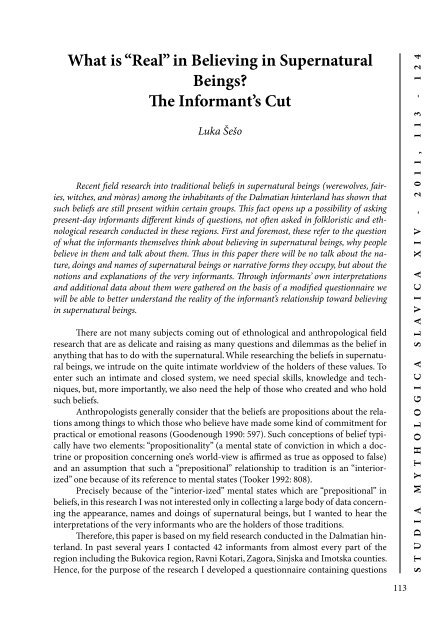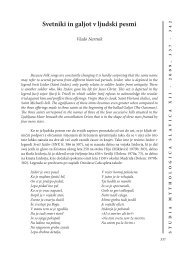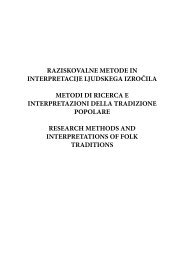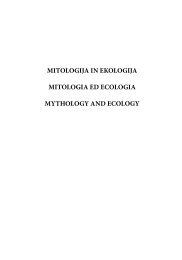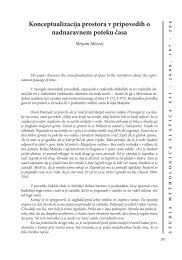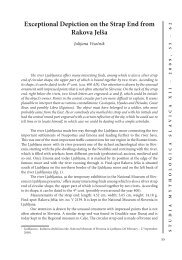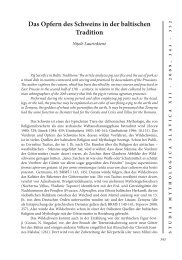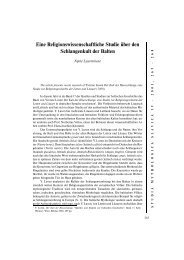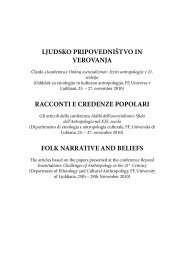âRealâ in Believing in Supernatural Beings? The Informant's Cut
âRealâ in Believing in Supernatural Beings? The Informant's Cut
âRealâ in Believing in Supernatural Beings? The Informant's Cut
- No tags were found...
Create successful ePaper yourself
Turn your PDF publications into a flip-book with our unique Google optimized e-Paper software.
What is “Real” <strong>in</strong> Believ<strong>in</strong>g <strong>in</strong> <strong>Supernatural</strong> Be<strong>in</strong>gs? <strong>The</strong> Informant’s <strong>Cut</strong>this (Nikola), thus creat<strong>in</strong>g the impression that the existence of supernatural be<strong>in</strong>gs is <strong>in</strong>fact true. At that, their gesticulation, the expression of their faces and other non-verbalsegments would add to the suspense and credibility of their story, and frequently theywould switch their narration from the third to the first person and suddenly the mòrathat attacked their friend would become the mòra that the <strong>in</strong>formant once met <strong>in</strong> his orher sleep.If we analyze the refra<strong>in</strong>s the <strong>in</strong>formants used and if we take <strong>in</strong>to consideration theverbal components and the emotional tension, we can conclude that these are not semioticbut apophantic testimonies <strong>in</strong> which the <strong>in</strong>formants leave the possibility that they do notnecessarily speak the truth. Such examples <strong>in</strong> which the <strong>in</strong>formants claim that it was theywho saw a fairy, that a mòra “harassed” them or that there “is someth<strong>in</strong>g there”, have a narrativefunction of creat<strong>in</strong>g suspense, <strong>in</strong>trigue, excitement and are a constitutive element ofthe genre of mythic tales. Here the listener has the impression that the narrator believes<strong>in</strong> the delivered content. Also they often use names of real persons who experienced suchth<strong>in</strong>gs, they list localities and dates (Rudan 206: 96). <strong>The</strong> retell<strong>in</strong>g of someone else’s encounterswith the supernatural often turns <strong>in</strong>to the first person narration <strong>in</strong> order to givea more excit<strong>in</strong>g tone to the story (Bošković-Stulli 1991: 190).In the third group, 4 <strong>in</strong>formants stated that they did not believe <strong>in</strong> the existence ofsupernatural be<strong>in</strong>gs, but that they believed that people used to amuse themselves withstories of such (imag<strong>in</strong>ed) be<strong>in</strong>gs <strong>in</strong> the moments of boredom. <strong>The</strong> usual answers to myquestion were:All of this was <strong>in</strong>vented, all those stories about the dead, of them ris<strong>in</strong>g. Comew<strong>in</strong>ter, they’d get bored, so they’d gather and tell these foolish stories. (Marta).When we would sit around <strong>in</strong> a house, stories would be told. Some were listenedto, others not. Some knew how to tell a story better, they knew how to <strong>in</strong>ventth<strong>in</strong>gs. (Nikola).<strong>The</strong>se stories were told around a fireplace. It was important not to spend toomuch wood, so everyone would gather at one house. People who never movedanywhere, they scared people and would get drunk. (Mare).As can be seen, even some of the more recent testimonies about the circumstances<strong>in</strong> which such stories were told showed that <strong>in</strong> the past the stories about supernaturalbe<strong>in</strong>gs served as a form of enterta<strong>in</strong>ment, especially <strong>in</strong> w<strong>in</strong>ter, when people did not havemuch work. People gathered for company or to save firewood. But, as Bošković-Stulli observes,such circumstances, <strong>in</strong> which the stories were told <strong>in</strong> the above-described manner,had almost disappeared already at the time of her own research (1950s and 1960s) becauseof the migration and changes <strong>in</strong> the way of life (Bošković-Stulli 1967-68: 311-312). Todaythe <strong>in</strong>formants covered by this field research also emphasize that those stories were morefrequent <strong>in</strong> the past, while today they do not exist. However, even though the way of life,that is, the social and economic changes that took place <strong>in</strong> the last fifty years, have considerablychanged the circumstances <strong>in</strong> which the stories were told, they still <strong>in</strong> a certa<strong>in</strong> formexist even today. Dur<strong>in</strong>g my field research I had no opportunity to participate <strong>in</strong> even<strong>in</strong>gsit-togethers, corn shuck<strong>in</strong>g and similar gather<strong>in</strong>gs where the members of the community116
Luka Šešocovered by my research talked about supernatural be<strong>in</strong>gs, but dur<strong>in</strong>g my <strong>in</strong>terviews I actuallymanaged to create such situations and raised curiosity with many <strong>in</strong>habitants whereverI conducted my <strong>in</strong>terviews. While <strong>in</strong>terview<strong>in</strong>g some <strong>in</strong>dividuals, it often happenedthat someone “dropped <strong>in</strong>” or that the neighbor saw me sitt<strong>in</strong>g <strong>in</strong> front of the house withmy <strong>in</strong>formant and decided to jo<strong>in</strong> us at the table and share his/her story. Also, occasionallysome older people from the village were called to come to the house where the <strong>in</strong>terviewwas tak<strong>in</strong>g place <strong>in</strong> order to participate <strong>in</strong> it by reveal<strong>in</strong>g some of their knowledgeabout supernatural be<strong>in</strong>gs. This led to spontaneous situations <strong>in</strong> which more <strong>in</strong>habitantstook part <strong>in</strong> the <strong>in</strong>terview, such as the situations mentioned by Bošković-Stulli. Perhaps itshould be po<strong>in</strong>ted out that at the given moment probably any other topic would provokecuriosity with the villagers who are eager for amusement, socializ<strong>in</strong>g and exchang<strong>in</strong>g stories.However, it is significant to notice that almost every “guest” knew someth<strong>in</strong>g or quitea lot about supernatural be<strong>in</strong>gs, often got <strong>in</strong>volved <strong>in</strong> the narration and <strong>in</strong> this way contributedto the already-mentioned suspense, drama or mysticism of the stories. So, tell<strong>in</strong>gstories about supernatural be<strong>in</strong>gs still has or, if <strong>in</strong>duced from the outside, it can have thefunction of socialization and amusement. Even though various social changes led to thedisappearance of fundamental predispositions that <strong>in</strong> the past stimulated people to gatherand tell stories, it is still possible to create situations that take the contours of the previousconditions and <strong>in</strong> which the stories of supernatural be<strong>in</strong>gs play the role of amusement andsocialization which is often emphasized by the <strong>in</strong>formants themselves.In the fourth group we have 4 <strong>in</strong>formants who emphasized that now they no longerbelieved <strong>in</strong> supernatural be<strong>in</strong>gs, but that they used to believe <strong>in</strong> them when they werechildren and that now they believed those stories used to play an important role <strong>in</strong> thechildren’s up-br<strong>in</strong>g<strong>in</strong>g.A werewolf, that’s a devil used to scare the children. If they misbehaved, a werewolfwould come and take them away. (Miho).<strong>The</strong> elderly made up the stories. <strong>The</strong> children were scared of these stories.Witches, fairies and werewolves... (Andrija).On Carnival days, our father would not let us out; he would say: “Tonight we donot open the doors, every freak and every witch is out.” (Mara).<strong>The</strong>y used fairies to scare children. Fairies were beautiful and nice, but peoplewere afraid as fairies were made out of beautiful girls. (Anka).<strong>The</strong> <strong>in</strong>formants’ explanations tell us how the th<strong>in</strong>gs worked some fifty years agowhen they were children. But what is the situation today? Today <strong>in</strong> the Dalmatian h<strong>in</strong>terland,unfortunately, we cannot f<strong>in</strong>d children sitt<strong>in</strong>g around the table listen<strong>in</strong>g to theirelders’ stories. <strong>The</strong> first reason is, of course, the demographic picture, which is show<strong>in</strong>gthe region’s population decl<strong>in</strong>e, that is, the number of children born is decreas<strong>in</strong>g, and thevillages are mostly populated by the older population. <strong>The</strong> children who are born <strong>in</strong> theregion attend schools <strong>in</strong> larger towns and cities nearby; they often live <strong>in</strong> student homesbecause schools <strong>in</strong> their villages have long closed due to as <strong>in</strong>sufficient number of pupils.Although <strong>in</strong> the field I was unable to f<strong>in</strong>d any children whom I could ask about super-117
Luka Šešoand their behavior for years and that he came to the conclusion that werewolves, fairiesand other be<strong>in</strong>gs always appeared, or were mentioned, after difficult situations <strong>in</strong> lifesuch as war, drought, hunger, or death. After such events, people are prone to believe thatsupernatural be<strong>in</strong>gs are responsible for their hardships. People encounter them at the precisemoment or immediately after some accident happens and start believ<strong>in</strong>g that thesesupernatural be<strong>in</strong>gs are responsible for these events. After a catastrophe of some k<strong>in</strong>d,such be<strong>in</strong>gs are seen <strong>in</strong> the whirlw<strong>in</strong>d, <strong>in</strong> the humm<strong>in</strong>g of leaves, <strong>in</strong> a black cat, sheetsbe<strong>in</strong>g dried outside dur<strong>in</strong>g the night. So the people are prone to believe that a werewolfhas awakened, that fairies are walk<strong>in</strong>g through the woods and that mòras or witches arewalk<strong>in</strong>g through the village.<strong>The</strong>n I asked Milorad why he thought people were likely to connect the appearanceof supernatural be<strong>in</strong>gs to catastrophes and other similar events. Milorad answeredthat such events often rendered people psychologically <strong>in</strong>stable and prone to believe <strong>in</strong>unusual th<strong>in</strong>gs:People start talk<strong>in</strong>g about these th<strong>in</strong>gs when they get <strong>in</strong>to debt or some other evilbefalls them, such as this war that brought misfortune to us all. <strong>The</strong>n we f<strong>in</strong>dourselves <strong>in</strong> a specific situation, which makes us nervous, suspicious, and wecannot f<strong>in</strong>d a normal answer for why someth<strong>in</strong>g is happen<strong>in</strong>g to us. When thiswar happened, I started see<strong>in</strong>g a black cat – a mòra. It was jump<strong>in</strong>g on me <strong>in</strong>sleep, mak<strong>in</strong>g me unable to move. I didn’t know if it were a dream or if it werefor real. I knew that it couldn’t be, but I couldn’t get rid of the feel<strong>in</strong>g that it wasfor real. (Milorad).Based on the conversation with Milorad, it is clear that the people from this regionare <strong>in</strong>cl<strong>in</strong>ed to see supernatural be<strong>in</strong>gs dur<strong>in</strong>g unusual situations that are hard to accept.As he said, <strong>in</strong> such situations they see what they are familiar with, i.e. traditional supernaturalbe<strong>in</strong>gs that are by def<strong>in</strong>ition able to cause troubles. Similarly, the supernaturalbe<strong>in</strong>gs almost always appear dur<strong>in</strong>g or after an event as an answer and an unambiguoussign of someth<strong>in</strong>g <strong>in</strong>explicable, someth<strong>in</strong>g difficult to comprehend and therefore supernatural.While Milorad’s first explanation addresses the connection between the appearanceof supernatural be<strong>in</strong>gs and difficult life situations, his second explanation sheds light onthe background of the whole issue. This second explanation, which is actually an additionto the first one, is expressed <strong>in</strong> one sentence:Look<strong>in</strong>g back, every time supernatural be<strong>in</strong>gs were mentioned, they were misusedfor some evil do<strong>in</strong>g. (Milorad).Hence, we have a second explanation accord<strong>in</strong>g to which the belief <strong>in</strong> supernaturalbe<strong>in</strong>gs “exists” so that it can be (illegally) exploited for someone’s material benefit. Accord<strong>in</strong>gto Milorad, supernatural be<strong>in</strong>gs were used by particular <strong>in</strong>dividuals to scare otherpeople and ga<strong>in</strong> material benefit. <strong>The</strong> mechanism of us<strong>in</strong>g supernatural be<strong>in</strong>gs for thepurpose of <strong>in</strong>timidation functioned <strong>in</strong> such a manner that villa<strong>in</strong>s and thieves [...] wouldf<strong>in</strong>d mentally ill <strong>in</strong>dividuals and <strong>in</strong>fluence them to spread the stories. After 1945 they walkedat night <strong>in</strong> cha<strong>in</strong>s <strong>in</strong>cit<strong>in</strong>g the mentally ill to start the rumors. (Milorad)119
What is “Real” <strong>in</strong> Believ<strong>in</strong>g <strong>in</strong> <strong>Supernatural</strong> Be<strong>in</strong>gs? <strong>The</strong> Informant’s <strong>Cut</strong><strong>The</strong> thieves’ goal was to start the avalanche <strong>in</strong> the whole village by <strong>in</strong>timidat<strong>in</strong>g psychologicallyunstable people. By spread<strong>in</strong>g the story, accord<strong>in</strong>g to which fairies and werewolvesare walk<strong>in</strong>g through the village among the <strong>in</strong>habitants, fear would spread amongthe people and keep them locked <strong>in</strong> their houses at night. Thieves would use this situationto steal from barns and warehouses without fear that anyone would come and check thesuspicious sounds. Hence, it seems that one of the explanations for the existence of supernaturalbe<strong>in</strong>gs is their use for crim<strong>in</strong>al purposes such as robberies and thefts.Another <strong>in</strong>formant from Bukovica discussed the type of resourceful tricks thievesused <strong>in</strong> order to additionally frighten people and make them believe <strong>in</strong> supernatural be<strong>in</strong>gs.Dur<strong>in</strong>g the entire <strong>in</strong>terview, this <strong>in</strong>formant argued that werewolves were <strong>in</strong>ventedprecisely for the purpose of steal<strong>in</strong>g and robb<strong>in</strong>g people from the village.Werewolves are <strong>in</strong>vented. It was done by professional thieves to frighten people,so that they could steal dur<strong>in</strong>g night as ghosts. <strong>The</strong>y made the dolls and figurespeople saw themselves, us<strong>in</strong>g rags, sheets, quilts. To seem more real, they lit candles.Back then it was not allowed to walk through the graveyard or the narrowstreets. Thieves were the people from that village. (Ivan).<strong>The</strong> <strong>in</strong>formant from the neighbor<strong>in</strong>g region of Ravni Kotari agreed with this last <strong>in</strong>formant.He claimed that a nearby hill had always been the subject of various stories aboutwitches and that these stories were used by thieves to frighten people.<strong>The</strong> elderly <strong>in</strong>vented the stories that witches dance on Vrčevo Hill. It was likethis. <strong>The</strong>re was no electricity <strong>in</strong> the village and people could easily be frightened.Some villagers would frighten others so as to steal sheep and goats. When aperson died <strong>in</strong> the village, they told others they saw him resurrect. While the bellrang the Holy Mary, everybody stayed at home, and they stole. <strong>The</strong>re is a toweron Vrčevo hill, one could drive a car on the walls. <strong>The</strong>y would say they had seena light, while <strong>in</strong> reality they carried torches and the thieves frightened the people.I looked after sheep at nights and collected grass for oxen. If there were anywitches, I would have seen them and they would have taken me. (Mladen).said:A similar explanation was offered by the <strong>in</strong>formant from Dalmat<strong>in</strong>ska Zagora whoLet me tell you one th<strong>in</strong>g. At first, they said werewolf. Listen: there was no work,and there were many people. <strong>The</strong>re was no place where people could earn a liv<strong>in</strong>g.<strong>The</strong>re was no work, no factories, noth<strong>in</strong>g. <strong>The</strong> factory was sold, you couldn’tget a job anywhere. And then people would dress <strong>in</strong> black or white, go beh<strong>in</strong>d thegraveyard, <strong>in</strong> the woods, on the road, and scare you. And then people could gonowhere and then they would steal around the village. <strong>The</strong>y would steal sheep orhams or… I know what. And, that’s why there were werewolves. (Jakov)<strong>The</strong> answer of Janja from Bukovica shortly summarizes the problem:All that was <strong>in</strong>vented, so that some could steal. (Janja).120
Luka ŠešoEmphasiz<strong>in</strong>g the abuse of the belief <strong>in</strong> supernatural be<strong>in</strong>g for dishonest purposesand the search for psychophysical causes for such beliefs are characteristic of the <strong>in</strong>formantswe mostly f<strong>in</strong>d <strong>in</strong> Bukovica and the nearby Ravni Kotari. <strong>The</strong> fact that the <strong>in</strong>formantsbelong to this region can help us better understand why they show particular <strong>in</strong>cl<strong>in</strong>ationtoward such strong rationalizations. Namely, unlike other areas covered by the research,this region was strongly hit by the Croatian War of Independence. <strong>The</strong> mixed population(Croats and Serbs stand<strong>in</strong>g on opposite sides) that <strong>in</strong>habited Bukovica almost completelyescaped or was forced to leave. Dur<strong>in</strong>g the war the <strong>in</strong>habitants lived <strong>in</strong> larger urban centerssuch as Biograd, Zagreb or Zadar (when the Croats are <strong>in</strong> question) or <strong>in</strong> Belgrade,Novi Sad and Subotica (as far as the Serbs are concerned). After the war, one part of thepopulation returned to Bukovica and today the return<strong>in</strong>g Croats and Serbs live there underthe motto of peaceful coexistence.This new, complex ethno-political situation <strong>in</strong> Bukovica left a mark on the <strong>in</strong>habitants’position towards beliefs <strong>in</strong> supernatural be<strong>in</strong>gs. In their testimonies the <strong>in</strong>formantsnow often use strong self-censorship, which is most evident <strong>in</strong> the way they end theirsentences – this no longer exists, that’s all foolishness or only ill people believed <strong>in</strong> that – aswell as <strong>in</strong> the <strong>in</strong>formants’ reservation towards the testimonies they give. In this way the<strong>in</strong>formants refra<strong>in</strong> themselves from say<strong>in</strong>g anyth<strong>in</strong>g that would compromise their statusof peaceful returnees.Such a position towards the problem of believ<strong>in</strong>g <strong>in</strong> supernatural be<strong>in</strong>gs <strong>in</strong> Bukovicacan primarily be expla<strong>in</strong>ed by the <strong>in</strong>formants’ fear from the “<strong>in</strong>tellectual” elite walk<strong>in</strong>gabout the village and writ<strong>in</strong>g down everyth<strong>in</strong>g that is said. French ethnologist JeanneFavert-Saada noticed this same position while research<strong>in</strong>g the belief <strong>in</strong> witches <strong>in</strong> ruralFrance where people believed that the researchers of traditional beliefs (folklorists andethnologists) often considered the holders of such beliefs backward and primitive andthus the <strong>in</strong>formants were <strong>in</strong> “no hurry” to reveal their beliefs so as not to be consideredbackward (1980: 4). Thus the <strong>in</strong>formants <strong>in</strong> their testimonies often used self-censorshipor rationalized the problem so as not to be brought <strong>in</strong>to connection with such “backward”beliefs. However, when Bukovica is <strong>in</strong> question, such a position towards believ<strong>in</strong>g<strong>in</strong> supernatural be<strong>in</strong>gs is even more prom<strong>in</strong>ent because the <strong>in</strong>formants not only do notwant to be considered backward or primitive, but, more importantly, they do not want tobe considered backward or primitive Croats or Serbs. Similarly, the Bukovica <strong>in</strong>formantsstrive to demystify traditional beliefs <strong>in</strong> supernatural be<strong>in</strong>gs because, unlike the <strong>in</strong>formantsfrom other regions covered by the research, they do not have a strong feel<strong>in</strong>g of groupor local belong<strong>in</strong>g 4 because of the recent war <strong>in</strong> which the local population was <strong>in</strong> conflictwith each other. Thus the negation, rationalization and self-censorship of traditionalbeliefs <strong>in</strong> supernatural be<strong>in</strong>gs that were shared among the population before the war 5comes out of the (until recently warr<strong>in</strong>g) groups’ need to make a dist<strong>in</strong>ction between eachother. In other words, the Bukovica <strong>in</strong>formants have the need to deconstruct their sharedmemories and thus their negation, self-censorship and rationalization of such traditionsis understandable. F<strong>in</strong>ally, it is worth mention<strong>in</strong>g that all of the <strong>in</strong>formants covered bythe research dur<strong>in</strong>g the Croatian War of Independence spent a longer period of time <strong>in</strong>larger urban centers <strong>in</strong> which they came face to face with rational explanations of “back-4More about the relationship between the belief <strong>in</strong> supernatural be<strong>in</strong>gs and group affiliation cf. Šešo 2010.5Older literature and data deal<strong>in</strong>g with the beliefs <strong>in</strong> supernatural be<strong>in</strong>gs <strong>in</strong> Bukovica shows almost no difference<strong>in</strong> beliefs between Croats and Serbs (cf. eg. Ardalić, 1899, 1917).121
What is “Real” <strong>in</strong> Believ<strong>in</strong>g <strong>in</strong> <strong>Supernatural</strong> Be<strong>in</strong>gs? <strong>The</strong> Informant’s <strong>Cut</strong>ward” beliefs cherished by the older people from their villages. <strong>The</strong> confirmation of thiscame from the <strong>in</strong>formant Milorad who told me that dur<strong>in</strong>g his exile <strong>in</strong> Belgrade he hadread Erich von Däniken and Carlos Castaneda and realized that the supernatural be<strong>in</strong>gsfrom old people’s stories were actually foolishness. Accord<strong>in</strong>gly, it can be assumed that thetraditional beliefs <strong>in</strong> supernatural be<strong>in</strong>gs <strong>in</strong> Bukovica are additionally deconstructed anddirected at rapid decl<strong>in</strong>e due to the storytellers’ mass departure to larger urban centersdur<strong>in</strong>g the Croatian War of Independence, where they acquired detachment from such“backward” beliefs.ConclusionBy look<strong>in</strong>g at the answers the <strong>in</strong>formants gave to the question of what they themselvesthought about supernatural be<strong>in</strong>gs, we can conclude that, accord<strong>in</strong>g to the <strong>in</strong>formants,the belief <strong>in</strong> supernatural be<strong>in</strong>gs was <strong>in</strong>creas<strong>in</strong>g dur<strong>in</strong>g or immediately after situationsof social hardships and catastrophes. Such hardships primarily refer to wars, outbreaks,natural disasters and economic crises. Dur<strong>in</strong>g and immediately after such events,two groups of people appear. <strong>The</strong> first group is comprised of those who have becomepsychologically <strong>in</strong>stable and are <strong>in</strong>cl<strong>in</strong>ed to believe <strong>in</strong> the existence of supernatural be<strong>in</strong>gs,which somehow represent either the answer to the hardship or a sign, a climax of thathardship. <strong>The</strong> second group is simply try<strong>in</strong>g to use this situation for their material profit.In the situation of complete chaos of a village or an <strong>in</strong>dividual, the members of the secondgroup reach out to supernatural be<strong>in</strong>gs from traditional beliefs, which are strongly rooted<strong>in</strong> the consciousness of the <strong>in</strong>habitants of the Dalmatian h<strong>in</strong>terland. Reproduc<strong>in</strong>g variousvalues and symbols ascribed to supernatural be<strong>in</strong>gs by traditional beliefs, a group of profiteerswittily uses them, hence manag<strong>in</strong>g to manipulate other <strong>in</strong>habitants.However, if we look at the explanations given by some other <strong>in</strong>formants, we can immediatelynotice that supernatural be<strong>in</strong>gs are always mentioned as a tool for the realizationof certa<strong>in</strong> goals. <strong>The</strong>y are used as objects of enterta<strong>in</strong>ment and socialization, for the purposeof the construction and ma<strong>in</strong>tenance of social norms, i.e. the upbr<strong>in</strong>g<strong>in</strong>g of children,as an excuse for various hardships of life, drunkenness, etc. In all these segments of humanlife, supernatural be<strong>in</strong>gs with their characteristics, values and symbols provide support.<strong>The</strong>y help us <strong>in</strong> the world that surrounds us and poses many more questions and createsmore obstacles than it provides answers and offers support. One has to f<strong>in</strong>d these on one’s,sometimes with the support of supernatural be<strong>in</strong>gs, or as my last <strong>in</strong>formant said:Whatever a person believes, it helps him. (Jakov).BibliographyArdalić, Vladimir. 1899. “Bukovica. Narodni život i običaji”. Zbornik za narodni život iobičaje 4/1: 113–126.Ardalić, Vladimir. 1917. “Vještica i vila. (Bukovica u Dalmaciji)”. Zbornik za narodni životi običaje 22: 302–311.Bošković-Stulli, Maja. 1967/68. “Narodne pripovjetke i predaje S<strong>in</strong>jske kraj<strong>in</strong>e”. Narodnaumjetnost. Hrvatski časopis za etnologiju i folkloristiku 5/6: 303–432.122
Luka ŠešoBošković- Stulli, Maja. 1991. Pjesme, priče, fantastika. Zagreb. Nakladni zavod Matice hrvatske,Zavod za istraživanje folklora.Briggs, Charles L. 2008. “Discipl<strong>in</strong><strong>in</strong>g Folkloristics”. Journal of Folklore Research 45/1:91–105.Đorđević, Tihomir R. 1953. “Veštica i vila u našem narodnom verovanju i predanju. Vampiri druga bića u našem narodnom verovanju i predanju”. Srpski etnografski zbornik66: 5–255.Favret-Saada, Jeanne. 1980. Witchcraft <strong>in</strong> the Bocage. Cambridge. Cambridge UniversityPress.Goodenough, Ward E. 1990. “Evolution of the Human Capacity for Beliefs”. AmericanAnthropologist 92/3: 597–612.Hameršak, Marijana. 2009. “Usmenost za djecu u hrvatskoj etnologiji i folkloristici”. StudiaEthnologica Croatia 21: 233–254.Honko, Lauri. “Gaisterglaube <strong>in</strong> Ingermanland”. FF Communications 185: 5–470.Rudan, Evel<strong>in</strong>a. 2006. “Authentication Formulae <strong>in</strong> Demonological Legends”. Narodnaumjetnost. Hrvatski časopis za etnologiju i folkloristiku 43/1: 89–111.Šešo, Luka. 2007. “Vjerovanje u bića koja se pretvaraju u život<strong>in</strong>je”. In Kulturni bestijarij,eds. Antonija Zaradija-Kiš, Suzana Marjanić. Zagreb. Hrvatska Sveučilišna naklada:253–275.Šešo, Luka. 2010. “Kazivanja o nadnaravnome – prema lokalnim temeljima grupne pripadnosti”.Etnološka trib<strong>in</strong>a 33: 107–114.Tooker, Deborah E. 1992. “Identity Systems of Highland Burma: ‘’Belief’’, Akha Zan, anda Critique of Interiorized Notions of Ethno-Religious Identity”. Man, New Series27/4: 799–819.Vukanović, Tatomir P. 1989. “Witchcraft <strong>in</strong> the Central Balkans I. Characters of Witches”.Folklore 100/1: 8–24.123
What is “Real” <strong>in</strong> Believ<strong>in</strong>g <strong>in</strong> <strong>Supernatural</strong> Be<strong>in</strong>gs? <strong>The</strong> Informant’s <strong>Cut</strong>Što je “stvarno” u vjerovanju u nadnaravna bića. Kazivačeva verzijaLuka ŠešoNedavna terenska istraživanja tradicijskih vjerovanja u nadnaravna bića (vukodlake,vile, vještice, more i dr.) među stanovništvom dalmat<strong>in</strong>skog zaleđa pokazala su još uvijeksnažnu prisutnost takvih vjerovanja. Ta č<strong>in</strong>jenica otvara nam mogućnost da današnjimkazivačima postavimo neka pitanja koja se u dosadašnjim folklorističkim i etnološkimbavljenjima ovom temom na ovim prostorima nisu često postavljala. Riječ je prvenstvenoo pitanju što sami kazivači misle zašto postoje vjerovanja u nadnaravna bića, zašto ljudi unjih vjeruju i o njima pričaju. Stoga se u ovom radu autor ne bavi izgledom, djelovanjemi nazivljem nadnaravnih bića ili narativnim formama, već u prvom redu razmišljanjima itumačenjima samih kazivača. Kroz vlastite <strong>in</strong>terpretacije kazivača i dodatne <strong>in</strong>formacije okazivaču prikupljene uz pomoć modificirane upitnice (koja obuhvaća društveni položaj,profesiju, obrazovanje i migracije kazivača iz dalmat<strong>in</strong>skog zaleđa) autor nastoji razumjetistvarnost kazivačeva odnosa prema vjerovanju i pričanju o nadnaravnim bićima.124


